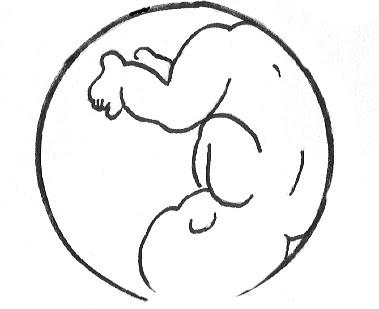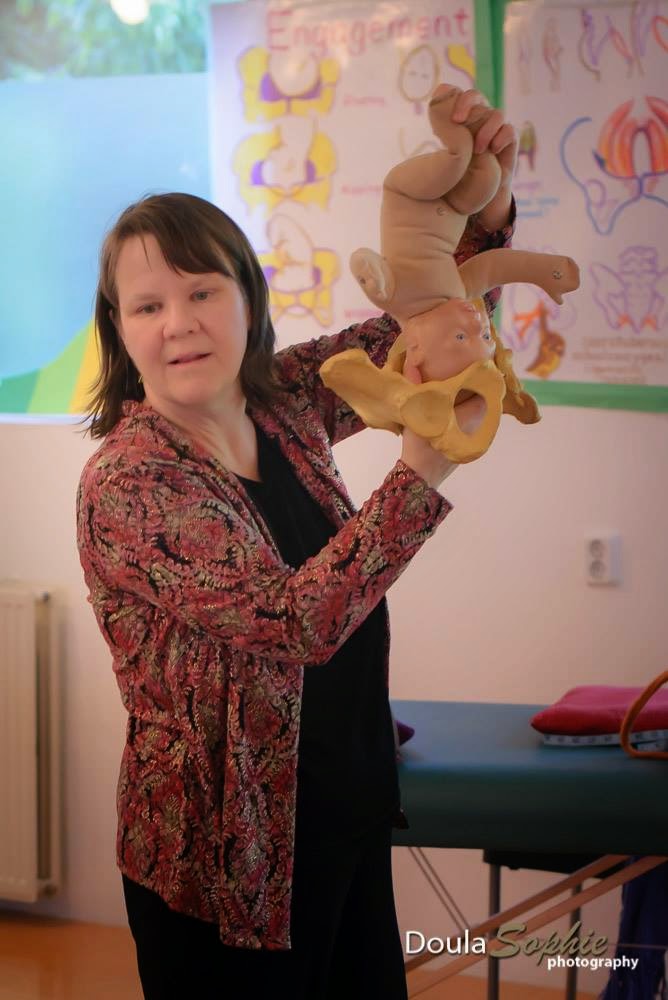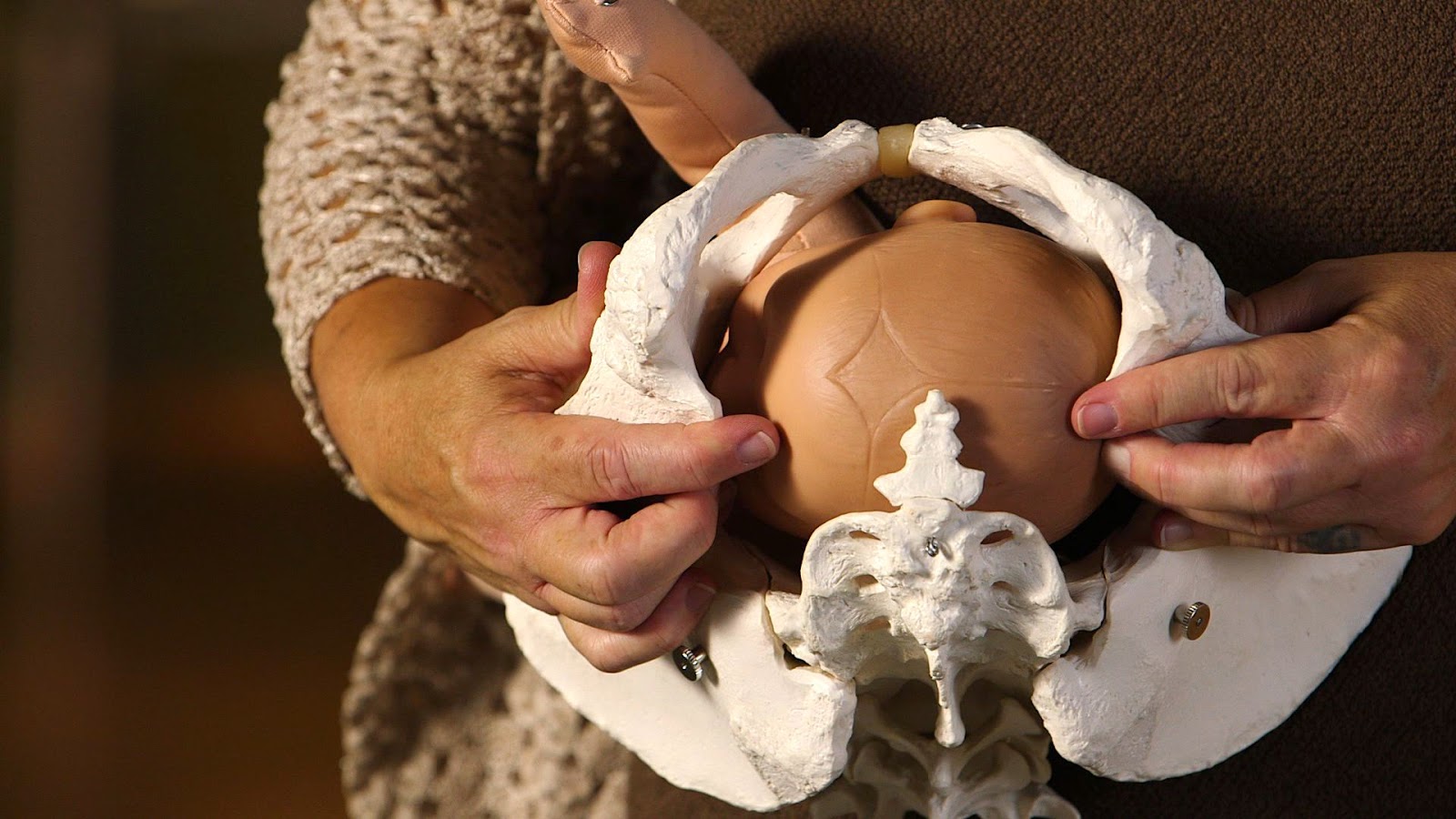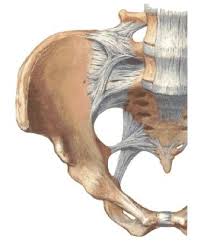[et_pb_section fb_built=”1″ admin_label=”section” _builder_version=”3.22″][et_pb_row admin_label=”row” _builder_version=”3.25″ background_size=”initial” background_position=”top_left” background_repeat=”repeat”][et_pb_column type=”4_4″ _builder_version=”3.25″ custom_padding=”|||” custom_padding__hover=”|||”][et_pb_text admin_label=”Text” _builder_version=”3.27.4″ background_size=”initial” background_position=”top_left” background_repeat=”repeat”]

The Occiput Posterior baby is head down with the back of baby’s head, or occiput, towards mom’s posterior, or back. The posterior positions are LOP, ROP, OP, and midwife Jean Sutton includes ROT due to the strong tendency for the ROT baby to rotate to posterior before the end of the birth process).
Facing forward makes the baby’s head seem bigger. This is because the head angles into the pelvis in a larger diameter than the baby’s who is curled up and facing the mom’s back (OA). Baby can’t help with the birth because their neck is already extended, they have less spinal movement because of spinal extension.
Anterior babies have the room for more flexion to get into the pelvis (at the brim) and can then help with the birth better. Spinal flexion and extension help with the birth – when they occur at the proper level of the pelvis.
 Left Occiput Anterior position
Left Occiput Anterior position
For first time mothers, just less than half have a vaginal birth if the baby is not engaged when labor begins. Not even half of the babies who are in direct OP at the time of delivery were born vaginally. I believe many of the babies who do not engage are in the posterior position and can be helped to rotate and engage.
Posterior babies may have their chin up and when so, can have their forehead on the front of the mother’s pelvic brim. Even if the dome of baby’s head is low in the pelvis, the fact that the forehead remains overlapping the pelvic inlet means that the baby is not actually engaged.
Baby has to flex, or to flex and turn, to fit into the pelvis. We hope the baby turns to face mother’s right side, putting their back to mother’s left. Baby being hung up on the brim is a common reoccurrence in VBAC (Vaginal Birth after Cesarean) labors when the first labor was due to lack of engagement.
If a baby was stuck at 0 station, the usual reason is that baby remains facing one of the mother’s hips and hasn’t turned to get past the boney bumps called the ischial spines- the narrow part of the middle pelvis. The baby may, alternatively, have started labor posterior and began the turn at the pelvic floor found at 0 Station. Now stuck on the ischial spines, the baby can’t fit the long angle of the head, which is to the mother’s side, through the narrow midpelvis. Rotation can be hard for baby to turn at 0 station due to the ischial spines are holding baby from turning, and sometimes from pelvic floor tension.

Baby must turn or all the Pitocin, pushing or contractions will not bring baby down. The rotation solution is to help baby turn to the oblique diameter or to face the back directly to fit.
Would it happen again? It might, small chance? Solution? Works like a charm – if the sacrum isn’t pulled in…
Pitocin may help if the head isn’t actually caught on the bones. Give the list above a try first if you can. Be precise with the Sidelying Release. You may be able to solve the issue within an hour and if not, then give the Pitocin a try (if in the hospital).
An immobile sacrum doesn’t move out of baby’s way in labor. All the exercise and most of the self-care suggested on my website and in my workshop is not likely to help if the sacrum is pulled in by a short (due to a chronic spasm) ligament pulling it into baby’s path.
Pitocin is unlikely to help bring baby down.
Mobilizing the stuck sacrum outward takes a specific release from a body worker or physical therapist. Trigger point release may help. It takes about ten minutes generally. In tougher cases, longer. But once done the sacrum swings out and, if the baby was held back by it, now descends to give the birthing mother an urge to push.
 Illustration by Netter.
Illustration by Netter.
The sacrotuberous ligament connects the sacrum with the ischial tuberosity. Think of it this way, the stretchy bridge between the sacrum and the site bone can become shortened (tight) and then brings the sacrum into baby’s path. The trigger point to release it is next to the tailbone on the inside/underside of the ligament – actually you can reach that from the outside of the body, you don’t have to go inside to find it but you will still be in a very personal space. Not all professionals will touch it there, because of it being in such a personal area (near enough to the anus to feel the warmth, if I may be so blunt). A doctor or midwife can access that spot and 2 minutes of mild stretching and it tends to release and the sacrum becomes mobile for a while until it tightens up again. Sometimes, a good body worker will help it resolve long term. Helping the cranials have free motion will help the sacrum. See a craniosacral therapist to make sense of that, please.
Massage of any small adhesions surround the sacrum, acupressure or acupuncture, chiropractic, and forward-leaning inversion followed by “shake the apple tree” may also help a lot if this is a borderline issue or tension is from muscles not sacrotuberous ligament.
Would it happen again? Yes, unless the sacrum was mobilized to swing out into its neutral position. Recheck the sacrotuberous ligaments periodically in the later part of the next pregnancy AND during birth.
A little less than half of persistent posterior babies are born vaginally in modern university settings (See Lieberman, 2005). With better knowledge of how to open pelvic diameters, soften and lengthen pelvic muscles and ligaments, I believe we can increase the rate of vaginal birth for persistent posterior babies.
[tribe_events_list limit=”4″]
[/et_pb_text][/et_pb_column][/et_pb_row][/et_pb_section]